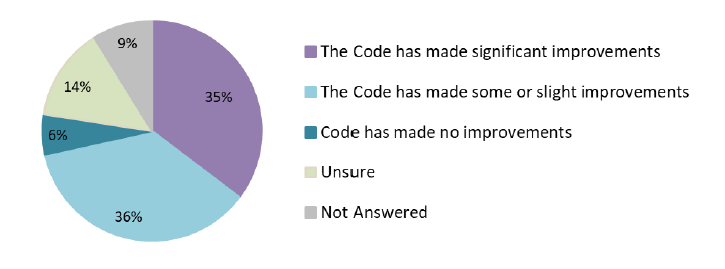Draft revised code of conduct for registered property factors: consultation analysis
This report presents an analysis of responses to the consultation on a draft revised code of conduct for registered property factors.
Part 1 - The Impact of the original Code of Conduct for Property Factors
In Part 1, the consultation paper asked for views on the impact of the original Code of Conduct for Property Factors published in October 2012.
Question 1 - Do you think the original Code of Conduct for property factors has led to improvements in the quality of factoring services provided to homeowners by property factors?
As illustrated in Figure 1 below, respondents were evenly divided as to whether the original Code has made significant improvements (35%) or has made some or slight improvements (36%) while 6% felt there has been no improvement.
Figure 1: Responses to Question 1. Also see Table 2 (Annex 2: Quantitative Analysis).

Improvements identified
Those who identified improvements most frequently suggested that the original Code has defined the minimum standards of service required of property factors or provided a legal and/or professional framework within which property factors now work. Other positive impacts identified included:
- Clarifying the responsibilities of a factor and encouraging factors to review and improve the services they provide.
- Requiring factors to be registered and helping to eliminate rogue operators.
- Increasing transparency and accountability.
- Making homeowners more aware of their rights.
A small number of individual respondents related positive personal experiences of their current factor, suggesting this might indicate positive effects of the current Code. However, it was also suggested that reputable factors already met the required standards before the Code was introduced and, in these cases, there will have been less impact. A small number of respondents identified the greatest impact as being among factors who previously did not operate at an acceptable level. While it was suggested that the level of improvement may have been greatest in the private sector since housing associations were already heavily regulated, one RSL (acting as a property factor) also identified improvements made within their own services.
The specific aspects of the Code most frequently suggested to have resulted in improved standards were:
- Introduction of a Written Statement of Services (WSS) resulting in improved clarity/transparency.
- Complaints Resolution via an independent complaints body leading to improved accountability.
- Communication and consultation having been improved, including amongst organisations that already had their own codes in place.
Small numbers of respondents pointed to improvements resulting from the sections of the Code concerning: financial regulation; debt recovery; insurance; carrying out repairs and maintenance.
The work of the First-tier Tribunal for Scotland (Housing and Property Chamber) was referenced by a number of respondents including that:
- Recommendations made by members of the First-tier Tribunal (FTT) for strengthening the Code to make it even more effective should be supported where there is merit and value in doing so.
- Useful lessons may be learned by sharing information from cases brought.
- Improvement may be inferred in some areas (such as communication and complaints handling) from the small number of cases brought.
On-going problems identified
Individual respondents expressing a view that the original Code has made no improvements sometimes related personal experience of poor service provided by one or more factors.
Among other respondents identifying problems with the Code the most frequently made suggestion was that more robust enforcement is needed to deal with factors who do not comply. Related points included that:
- The Code is sometimes ignored.
- Some factors continue to provide a poor service.
- Factors found to be in breach of the Code on multiple occasions should be removed from the register or fined a more significant amount.
- Some factoring companies are not registered and the lack of enforcement of registration is unfair to those who do comply. A minority of smaller factors do not appear to learn from their mistakes and are appearing before the FTT on numerous occasions.
Other problems identified with the original Code included:
- It sets out a process for property factors to follow but does not specify minimum standards in delivery of the service. It does not deal with customer service issues, and high levels of customer satisfaction are rare.
- Some local authorities are selective about the elements adopted or do not register as factors for some mixed ownership blocks.
- Factors may omit or misrepresent the requirement of some sections of the Code in their WSS.
- Some factoring customers are not aware of the Code or have insufficient understanding of the role and legal status of property factors. Some homeowners may still be unclear what they can expect and may find it difficult to resolve disputes.
- For some organisations, compliance with the Code has had an adverse impact on costs and workload and so has reduced the resources available to develop the service being provided.
A small number of other respondents at Question 1 drew attention to the work of the Glasgow Factoring Commission, particularly referencing its suggestion that the Scottish Government should ‘review the overall legislative framework relating to common property management and repair’. It was also suggested that the Scottish Government should introduce a mandatory requirement for appointment of common factors.
Contact
There is a problem
Thanks for your feedback